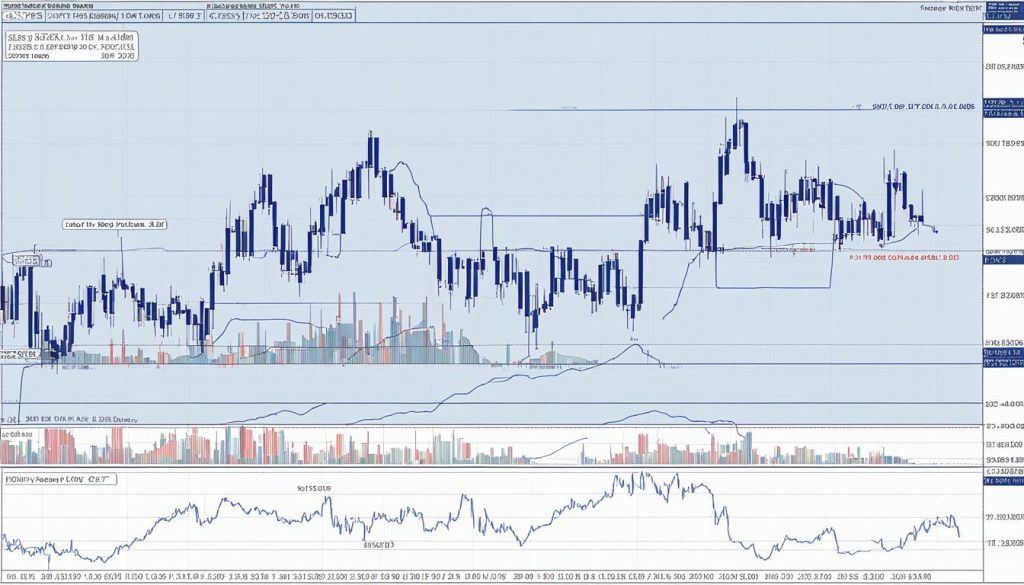The currency market is known for its staggering daily trading volumes, a clear indication of its fluidity and dynamism. Within this global market, certain forex pairs with most liquidity stand out, offering traders and investors highly liquid currencies that provide the advantage of easier entry and exit points. These liquid forex trading pairs are the powerhouses of forex trading, forming the backbone of daily currency transactions worldwide.
As a vital trait for any financial instrument, liquidity refers to the ease with which an asset can be quickly bought or sold in the market without causing a significant movement in its price. In forex, this attribute is particularly valued, as it signals robustness and a smaller cost of trade reflected in narrower spreads. Be it the bustling professional traders or the strategic long-term investors, most gravitate towards these eminent pairs for a smoother trading experience.
Understanding Forex Market Liquidity
In the dynamic landscape of the forex market, liquidity serves as a critical aspect for both stability and profitability. As currency traders navigate through the fluctuating realms of foreign exchange rates, an in-depth understanding of market liquidity is essential. The major currency pairs with high liquidity offer not only a seamless transaction experience but also ensure a firm ground for traders to execute strategies effectively.
Defining Liquidity in Forex Trading
Liquidity, in the context of forex trading, represents the capacity of a currency pair to be traded promptly without causing significant price variations. The most liquid currency pairs facilitate transactions that are executed swiftly and with minimal impact on their exchange rates. Major forex pairs with high liquidity, like EUR/USD, USD/JPY, and GBP/USD, epitomize such qualities, making them favored choices amongst traders.
Measuring Liquidity in Currency Pairs
To accurately gauge liquidity in the forex market, one considers the trading volume and market depth. Trading volume is a direct indicator of a currency pair’s liquidity, depicted as a percentage of turnover within the forex landscape. Let’s dive into a data table illustrating these figures for some of the most liquid currency pairs:
| Currency Pair | 2021 Trading Volume (%) | Spread |
|---|---|---|
| EUR/USD | 28.0% | 0.1 pips |
| USD/JPY | 13.0% | 0.2 pips |
| GBP/USD | 9.6% | 0.3 pips |
| AUD/USD | 4.6% | 0.4 pips |
| USD/CAD | 4.4% | 0.3 pips |
Why Liquidity Matters for Forex Traders
The significance of liquidity for traders is manifold. High liquidity in forex pairs reduces trading costs, reflected by tighter spreads and reduced potential for slippage. Furthermore, the predictability afforded by highly liquid markets allows for better strategic planning and risk management. Forex pairs with high liquidity, therefore, not only ensure smoother transactions but also bolster a trader’s confidence in navigating the intricacies of forex trading.
The Most Liquid Currency Pairs Revealed
Forex markets thrive on liquidity, and certain pairs have earned the title of being some of the top liquidity forex pairs traders prefer. Topping this list is the EUR/USD pair, which not only represents two of the largest economies in the world but also boasts a significant portion of market volume, resulting in high liquidity and tighter spreads.
The USD/JPY pair, heavily influenced by policies set by the Federal Reserve and the Bank of Japan, stands next in line. Known for its stability and economic significance, the USD/JPY also offers liquidity that is appealing to traders globally. Not to be overlooked is the GBP/USD, or ‘Cable,’ a term that originated from the transatlantic cables used to transmit the exchange rate between the U.S. and UK in the 19th century. It remains a liquid favorite in modern markets.
- AUD/USD
- USD/CAD
- USD/CHF
Each liquid forex pair, through its correlation with commodities or robust trade activity, contributes to an ecosystem where forex currency pairs with high liquidity become the cornerstone of vibrant trade.
| Forex Pair | Market Volume Significance | Factors Contributing to Liquidity |
|---|---|---|
| EUR/USD | Highest liquidity, substantial market volume | Two major economies, tight spreads |
| USD/JPY | High liquidity, significant in Asia | Interest rate decisions, economic policies |
| GBP/USD | Strong presence in the market | Economic relations, stability |
| AUD/USD | High commodity correlation | Metal and mineral exports |
| USD/CAD | Frequent trade activity with US | Oil price correlation |
| USD/CHF | Dependability in uncertain times | Safe-haven status, economic stability |
Additional pairs like USD/CNY and EUR/GBP hold their ground, supported by the considerable size and economic activities of the respective countries involved—China and the European Union/UK. As traders seek out liquid forex pairs for their portfolio, these pairs frequently come into focus for offering efficient entry and exit points, with minimal impact on price due to their liquid nature.
Exploring the Dynamics of EUR/USD as the Most Liquid Forex Pair
The EUR/USD pair stands out as a heavyweight in the forex market, epitomizing the height of liquidity due to its broad international appeal and the sheer scale of trading activity. As a pair that consistently ranks atop the most highly traded forex pairs, its movements offer insights into broader economic trends, showcasing the intertwined nature of the European and American economies.
Factors Influencing EUR/USD Liquidity
Liquidity in the EUR/USD currency pair can be attributed to several factors that reinforce its dominance. The economic policies of the Eurozone and the United States exert substantial influence on this pair’s trading volumes. Decisions by the European Central Bank (ECB) and the Federal Reserve (Fed) on interest rates command attention, driving currency values and trading volumes. As a result, the EUR/USD pair boasts not only high liquidity but also serves as a benchmark for the forex market’s health.
Trading Strategies for EUR/USD
Traders leveraging the high trading volume of the EUR/USD pair employ various strategies designed to maximize the benefits of its liquidity. Typically, these strategies revolve around catching minute price changes, a method known as scalping, or capitalizing on longer-term trends. The pair’s liquidity ensures tighter spreads, a crucial component for such short-term trading tactics. Meanwhile, long-term traders scrutinize macroeconomic indicators such as inflation rates, GDP growth, and employment statistics for trade opportunities. These strategies hinge on the pair’s liquidity, allowing for smooth entry and exit from the markets.
| Liquidity Factor | Influence on EUR/USD |
|---|---|
| Interest Rate Decisions | Central bank policies affect capital flows into currency markets, impacting the EUR/USD pair directly. |
| Economic Data | GDP reports, unemployment rates, and industrial production figures can cause significant price movements. |
| Geopolitical Events | Political stability and economic sanctions can induce volatility in the forex markets, affecting liquidity. |
| Market Sentiment | Investor confidence shifts can lead to increased trading volume and liquidity, impacting the EUR/USD spread. |
USD/JPY and GBP/USD: High Liquidity and Trading Volume
Within the realm of Forex trading, certain pairs are recognized for commanding the market with their robust liquidity and extensive trading volume. Among these elite pairs are the USD/JPY and GBP/USD, both revered for their economic importance and foundational roles in daily Forex turnover.
Understanding the Popularity of USD/JPY
The USD/JPY currency pair, often acknowledged as the go-to measure for Asian economic health, owes much of its high liquidity to Japan’s significant influence as a financial hub in Asia. The dynamism of this pair is primarily shaped by the interest rate decisions of the Bank of Japan (BoJ), which directly correlate with its valuation against the US dollar. The stability and depth of liquidity make the USD/JPY one of the highly traded forex pairs, thereby providing an attractive environment for traders seeking minimal slippage and swift execution.
What Drives GBP/USD in Forex Markets?
The presence of the GBP/USD pair, affectionately dubbed ‘Cable’, stretches far within Forex markets as it embodies the profound economic connection between the United Kingdom and the United States. It is the fluctuations in economic growth rates and the monetary policies of the Bank of England and the Federal Reserve that pivotally determine its exchange rates and liquidity. These elements, when combined, render Cable one of the forex pairs with high liquidity, continuously drawing traders to its competitive spreads and high-volume trading capacity.
Both the USD/JPY and GBP/USD currency pairs are exemplary in their contribution to the forex pairs with high liquidity category, their movements faithfully mirroring the geopolitical climate and policy changes within their respective economies. The chart below showcases these pairs’ inherent strengths, capturing their vast appeal within the Forex trading community.
| Forex Pair | Factors Contributing to Liquidity | Typical Volume Share |
|---|---|---|
| USD/JPY | Bank of Japan‘s interest rate decisions, Asian economic health | 13% |
| GBP/USD | Bank of England and Fed’s monetary policies, UK-US economic interactions | 11% |
As the Forex market continues to prosper, it is the consistent participation within these highly traded forex pairs that underpin the global financial landscape. Traders looking to capitalize on the lucrative opportunities presented by Forex trading often find their strategies tailored around the reliable liquidity of pairs like USD/JPY and GBP/USD.
Commodity Currencies: AUD/USD and USD/CAD’s Liquid Nature
The realm of liquid forex pairs is significantly influenced by currencies linked to their nation’s wealth in natural resources. The Australian dollar against the US dollar (AUD/USD) and the Canadian dollar against the US dollar (USD/CAD) are sterling examples of commodity currencies with high liquidity. These pairs, often driven by commodity price shifts, are vital players in the forex market, making up a considerable portion of the forex pairs with high trading volume.
Affectionately dubbed the ‘Aussie’, the AUD/USD pair epitomizes the connection between a country’s currency and its principal exports, which in Australia’s case include various metals and minerals. This connection anchors the Aussie’s value firmly to the ebbs and flows of global commodity prices. Parallelly, the USD/CAD, or ‘Loonie’, mirrors the oil-centric trade between Canada and its largest customer, the United States, given that Canada is a global leader in oil exportation. As such, fluctuations in oil prices heavily dictate the Loonie’s performance.
Furthermore, the liquidity of these currency pairs is reinforced by the considerable volume of trades they attract, stemming from their importance as indicators of the health of the commodity markets. Not to be overlooked, the fiscal policies of the Reserve Bank of Australia and the Bank of Canada, alongside the Federal Reserve’s own policies, are also instrumental in shaping the AUD/USD and USD/CAD exchange rates. As market participants navigate through the complexities of forex trading, the patterns and trends within these commodity-linked currencies serve as critical guides to understanding broader market movements.






